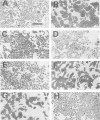Abstract
A cytotoxicity assay with Chinese hamster ovary cells (CHO) capable of detecting 750 pg of pertussis toxin was assessed for use as a rapid test for the diagnosis of pertussis and compared with direct immunofluorescence (DFA). With pure bacterial cultures and simulated clinical specimens, the CHO assay detected as few as two colonies of Bordetella pertussis; no cytotoxicity occurred with other respiratory tract microorganisms. Next, nasopharyngeal aspirate secretions and nasopharyngeal cultures harvested after 72 h of incubation from 57 culture-positive and 201 culture-negative patients were examined. The CHO assay with nasopharyngeal secretions was positive in 25 (45%) of 55 culture-positive cases; DFA was positive in 15 (26%) of 57 cases (P = 0.05). The CHO assay with 72-h culture washes was positive in 42 (75%) of 57 culture-positive cases (P less than 0.001 compared with DFA). The CHO assay was more specific than DFA; all five CHO-positive, culture-negative cases were confirmed as true positives by serologic or toxin neutralization assays. In contrast, only 4 (36%) of 11 DFA-positive, culture-negative cases were confirmed as pertussis by serologic methods (P = 0.03). Combining the CHO assay with culture significantly decreased the delay in laboratory diagnosis of pertussis (3.30 versus 4.54 days; P = 0.01). The CHO assay is a sensitive and specific assay for the rapid diagnosis of pertussis.
Full text
PDF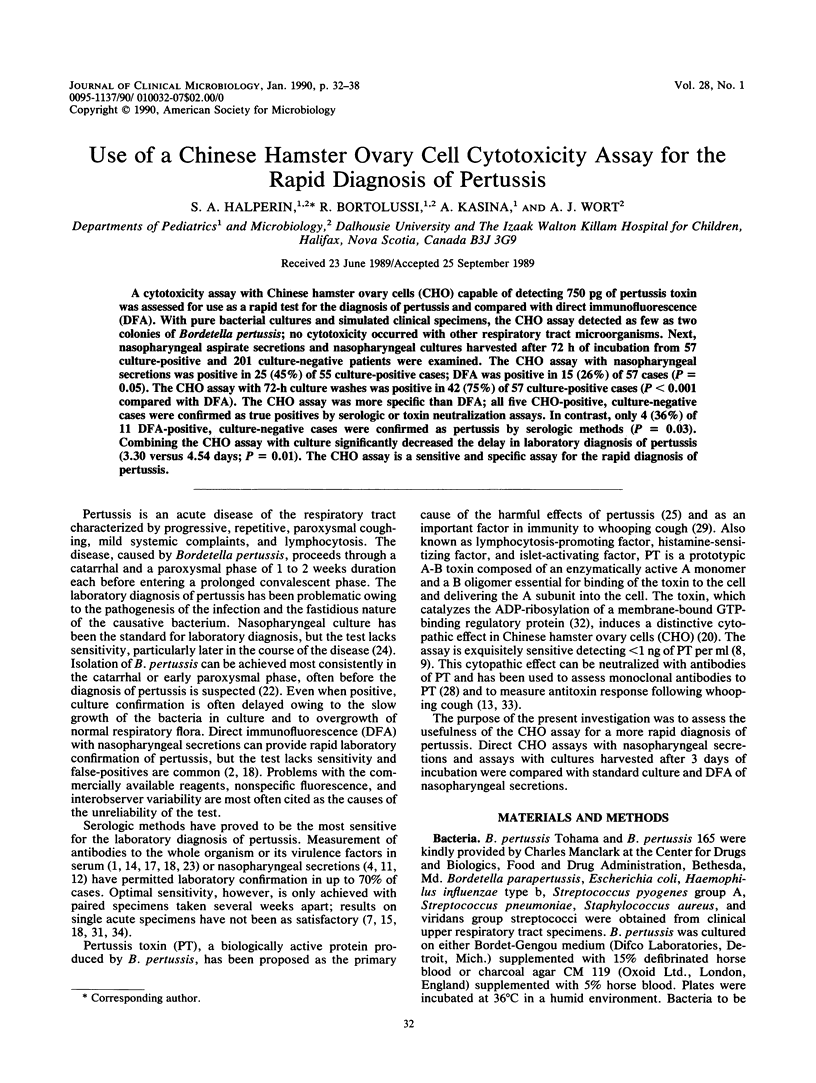
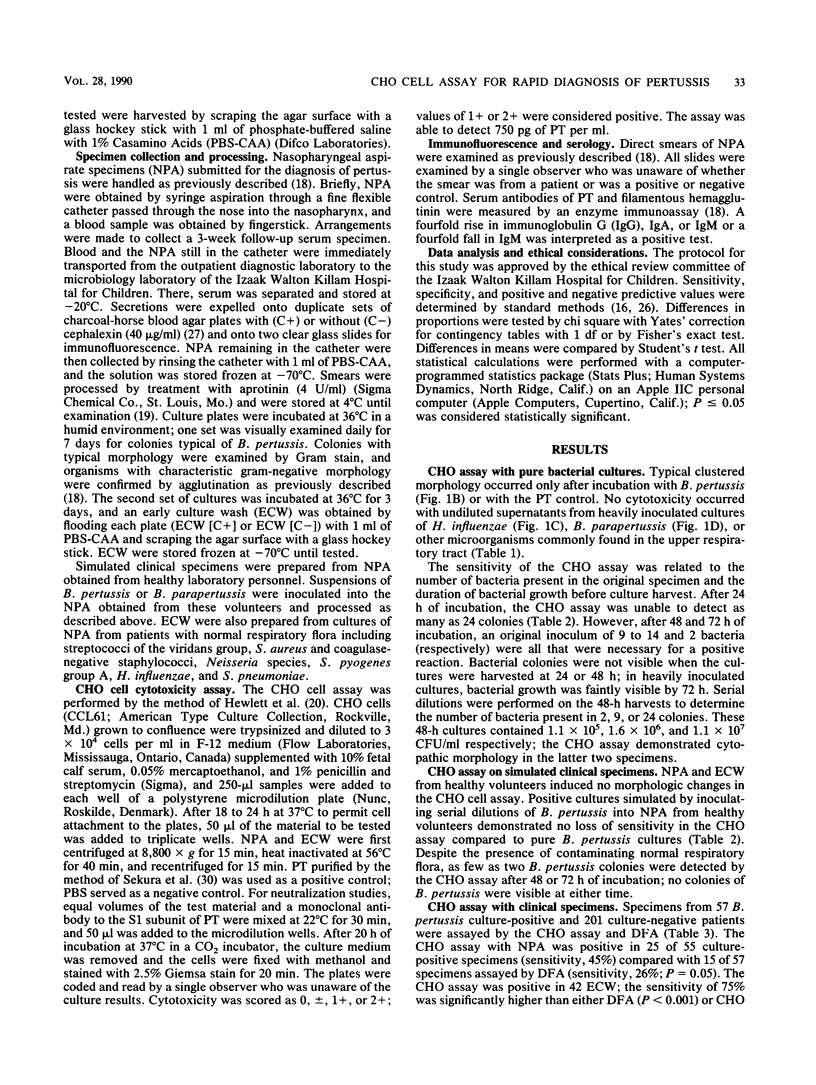
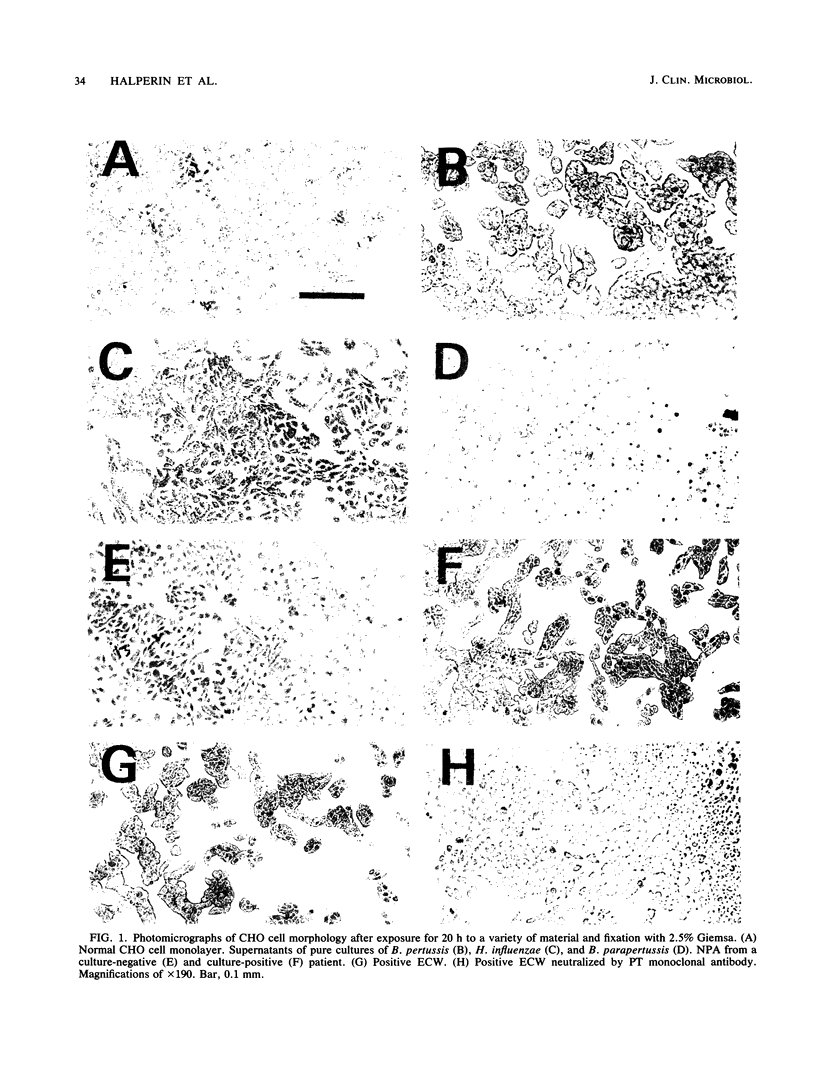
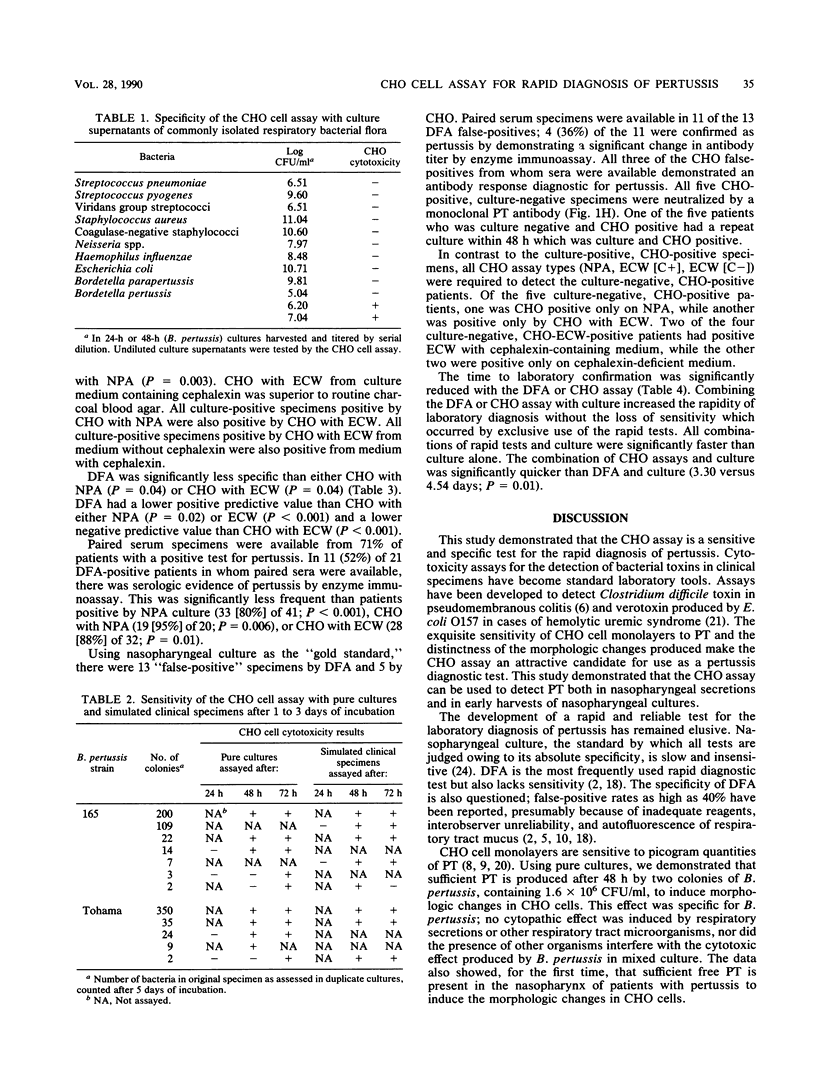
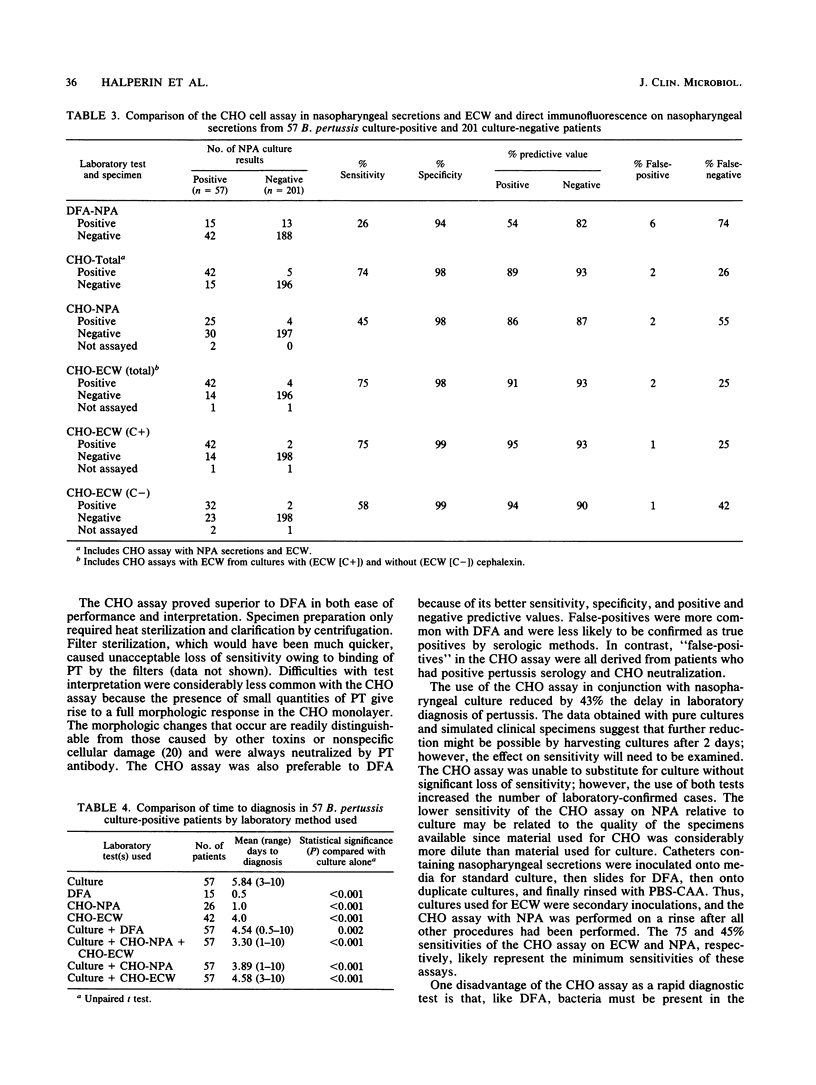
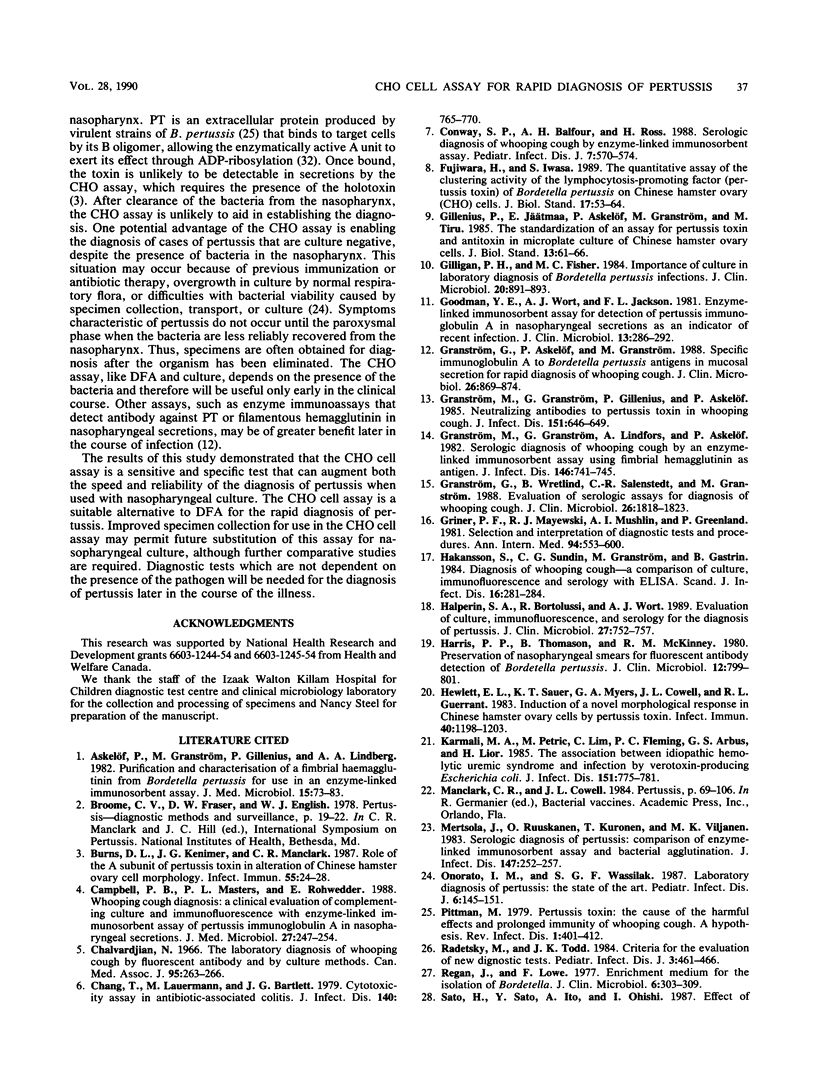
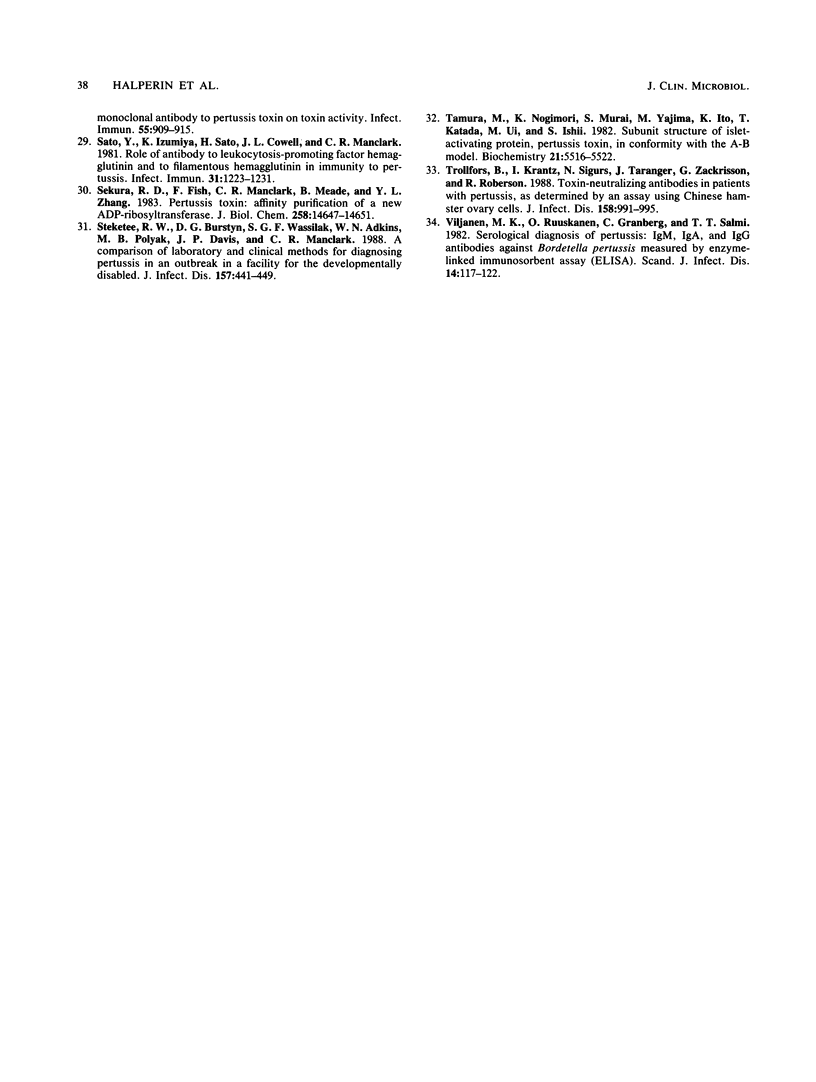
Images in this article
Selected References
These references are in PubMed. This may not be the complete list of references from this article.
- Askelöf P., Granström M., Gillenius P., Lindberg A. A. Purification and characterisation of a fimbrial haemagglutinin from Bordetella pertussis for use in an enzyme-linked immunosorbent assay. J Med Microbiol. 1982 Feb;15(1):73–83. doi: 10.1099/00222615-15-1-73. [DOI] [PubMed] [Google Scholar]
- Burns D. L., Kenimer J. G., Manclark C. R. Role of the A subunit of pertussis toxin in alteration of Chinese hamster ovary cell morphology. Infect Immun. 1987 Jan;55(1):24–28. doi: 10.1128/iai.55.1.24-28.1987. [DOI] [PMC free article] [PubMed] [Google Scholar]
- Campbell P. B., Masters P. L., Rohwedder E. Whooping cough diagnosis: a clinical evaluation of complementing culture and immunofluorescence with enzyme-linked immunosorbent assay of pertussis immunoglobulin A in nasopharyngeal secretions. J Med Microbiol. 1988 Dec;27(4):247–254. doi: 10.1099/00222615-27-4-247. [DOI] [PubMed] [Google Scholar]
- Chalvardjian N. The laboratory diagnosis of whooping cough by fluorescent antibody and by culture methods. Can Med Assoc J. 1966 Aug 6;95(6):263–266. [PMC free article] [PubMed] [Google Scholar]
- Chang T. W., Lauermann M., Bartlett J. G. Cytotoxicity assay in antibiotic-associated colitis. J Infect Dis. 1979 Nov;140(5):765–770. doi: 10.1093/infdis/140.5.765. [DOI] [PubMed] [Google Scholar]
- Conway S. P., Balfour A. H., Ross H. Serologic diagnosis of whooping cough by enzyme-linked immunosorbent assay. Pediatr Infect Dis J. 1988 Aug;7(8):570–574. [PubMed] [Google Scholar]
- Fujiwara H., Iwasa S. The quantitative assay of the clustering activity of the lymphocytosis-promoting factor (pertussis toxin) of Bordetella pertussis on Chinese hamster ovary (CHO) cells. J Biol Stand. 1989 Jan;17(1):53–64. doi: 10.1016/0092-1157(89)90028-0. [DOI] [PubMed] [Google Scholar]
- Gillenius P., Jätmaa E., Askelöf P., Granström M., Tiru M. The standardization of an assay for pertussis toxin and antitoxin in microplate culture of Chinese hamster ovary cells. J Biol Stand. 1985 Jan;13(1):61–66. doi: 10.1016/s0092-1157(85)80034-2. [DOI] [PubMed] [Google Scholar]
- Gilligan P. H., Fisher M. C. Importance of culture in laboratory diagnosis of Bordetella pertussis infections. J Clin Microbiol. 1984 Nov;20(5):891–893. doi: 10.1128/jcm.20.5.891-893.1984. [DOI] [PMC free article] [PubMed] [Google Scholar]
- Goodman Y. E., Wort A. J., Jackson F. L. Enzyme-linked immunosorbent assay for detection of pertussis immunoglobulin A in nasopharyngeal secretions as an indicator of recent infection. J Clin Microbiol. 1981 Feb;13(2):286–292. doi: 10.1128/jcm.13.2.286-292.1981. [DOI] [PMC free article] [PubMed] [Google Scholar]
- Granström G., Askelöf P., Granström M. Specific immunoglobulin A to Bordetella pertussis antigens in mucosal secretion for rapid diagnosis of whooping cough. J Clin Microbiol. 1988 May;26(5):869–874. doi: 10.1128/jcm.26.5.869-874.1988. [DOI] [PMC free article] [PubMed] [Google Scholar]
- Granström G., Wretlind B., Salenstedt C. R., Granström M. Evaluation of serologic assays for diagnosis of whooping cough. J Clin Microbiol. 1988 Sep;26(9):1818–1823. doi: 10.1128/jcm.26.9.1818-1823.1988. [DOI] [PMC free article] [PubMed] [Google Scholar]
- Granström M., Granström G., Gillenius P., Askelöf P. Neutralizing antibodies to pertussis toxin in whooping cough. J Infect Dis. 1985 Apr;151(4):646–649. doi: 10.1093/infdis/151.4.646. [DOI] [PubMed] [Google Scholar]
- Granström M., Granström G., Lindfors A., Askelöf P. Serologic diagnosis of whooping cough by an enzyme-linked immunosorbent assay using fimbrial hemagglutinin as antigen. J Infect Dis. 1982 Dec;146(6):741–745. doi: 10.1093/infdis/146.6.741. [DOI] [PubMed] [Google Scholar]
- Halperin S. A., Bortolussi R., Wort A. J. Evaluation of culture, immunofluorescence, and serology for the diagnosis of pertussis. J Clin Microbiol. 1989 Apr;27(4):752–757. doi: 10.1128/jcm.27.4.752-757.1989. [DOI] [PMC free article] [PubMed] [Google Scholar]
- Harris P. P., Thomason B., McKinney R. M. Preservation of nasopharyngeal smears for fluorescent antibody detection of Bordetella pertussis. J Clin Microbiol. 1980 Dec;12(6):799–801. doi: 10.1128/jcm.12.6.799-801.1980. [DOI] [PMC free article] [PubMed] [Google Scholar]
- Hewlett E. L., Sauer K. T., Myers G. A., Cowell J. L., Guerrant R. L. Induction of a novel morphological response in Chinese hamster ovary cells by pertussis toxin. Infect Immun. 1983 Jun;40(3):1198–1203. doi: 10.1128/iai.40.3.1198-1203.1983. [DOI] [PMC free article] [PubMed] [Google Scholar]
- Håkansson S., Sundin C. G., Granström M., Gästrin B. Diagnosis of whooping cough--a comparison of culture, immunofluorescence and serology with ELISA. Scand J Infect Dis. 1984;16(3):281–284. doi: 10.3109/00365548409070401. [DOI] [PubMed] [Google Scholar]
- Karmali M. A., Petric M., Lim C., Fleming P. C., Arbus G. S., Lior H. The association between idiopathic hemolytic uremic syndrome and infection by verotoxin-producing Escherichia coli. J Infect Dis. 1985 May;151(5):775–782. doi: 10.1093/infdis/151.5.775. [DOI] [PubMed] [Google Scholar]
- Mertsola J., Ruuskanen O., Kuronen T., Viljanen M. K. Serologic diagnosis of pertussis: comparison of enzyme-linked immunosorbent assay and bacterial agglutination. J Infect Dis. 1983 Feb;147(2):252–257. doi: 10.1093/infdis/147.2.252. [DOI] [PubMed] [Google Scholar]
- Onorato I. M., Wassilak S. G. Laboratory diagnosis of pertussis: the state of the art. Pediatr Infect Dis J. 1987 Feb;6(2):145–151. doi: 10.1097/00006454-198702000-00002. [DOI] [PubMed] [Google Scholar]
- Pittman M. Pertussis toxin: the cause of the harmful effects and prolonged immunity of whooping cough. A hypothesis. Rev Infect Dis. 1979 May-Jun;1(3):401–412. doi: 10.1093/clinids/1.3.401. [DOI] [PubMed] [Google Scholar]
- Radetsky M., Todd J. K. Criteria for the evaluation of new diagnostic tests. Pediatr Infect Dis. 1984 Sep-Oct;3(5):461–466. doi: 10.1097/00006454-198409000-00018. [DOI] [PubMed] [Google Scholar]
- Regan J., Lowe F. Enrichment medium for the isolation of Bordetella. J Clin Microbiol. 1977 Sep;6(3):303–309. doi: 10.1128/jcm.6.3.303-309.1977. [DOI] [PMC free article] [PubMed] [Google Scholar]
- Sato Y., Izumiya K., Sato H., Cowell J. L., Manclark C. R. Role of antibody to leukocytosis-promoting factor hemagglutinin and to filamentous hemagglutinin in immunity to pertussis. Infect Immun. 1981 Mar;31(3):1223–1231. doi: 10.1128/iai.31.3.1223-1231.1981. [DOI] [PMC free article] [PubMed] [Google Scholar]
- Sekura R. D., Fish F., Manclark C. R., Meade B., Zhang Y. L. Pertussis toxin. Affinity purification of a new ADP-ribosyltransferase. J Biol Chem. 1983 Dec 10;258(23):14647–14651. [PubMed] [Google Scholar]
- Steketee R. W., Burstyn D. G., Wassilak S. G., Adkins W. N., Jr, Polyak M. B., Davis J. P., Manclark C. R. A comparison of laboratory and clinical methods for diagnosing pertussis in an outbreak in a facility for the developmentally disabled. J Infect Dis. 1988 Mar;157(3):441–449. doi: 10.1093/infdis/157.3.441. [DOI] [PubMed] [Google Scholar]
- Tamura M., Nogimori K., Murai S., Yajima M., Ito K., Katada T., Ui M., Ishii S. Subunit structure of islet-activating protein, pertussis toxin, in conformity with the A-B model. Biochemistry. 1982 Oct 26;21(22):5516–5522. doi: 10.1021/bi00265a021. [DOI] [PubMed] [Google Scholar]
- Trollfors B., Krantz I., Sigurs N., Taranger J., Zackrisson G., Roberson R. Toxin-neutralizing antibodies in patients with pertussis, as determined by an assay using Chinese hamster ovary cells. J Infect Dis. 1988 Nov;158(5):991–995. doi: 10.1093/infdis/158.5.991. [DOI] [PubMed] [Google Scholar]
- Viljanen M. K., Ruuskanen O., Granberg C., Salmi T. T. Serological diagnosis of pertussis: IgM, IgA and IgG antibodies against Bordetella pertussis measured by enzyme-linked immunosorbent assay (ELISA). Scand J Infect Dis. 1982;14(2):117–122. doi: 10.3109/inf.1982.14.issue-2.08. [DOI] [PubMed] [Google Scholar]



